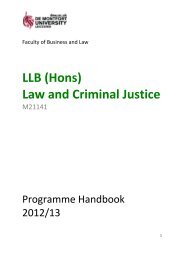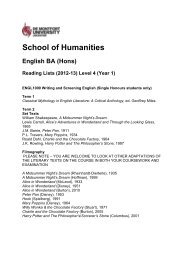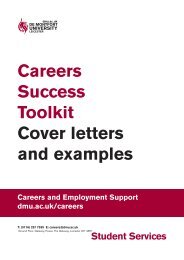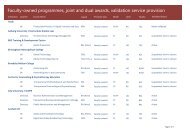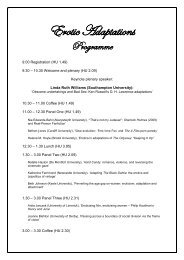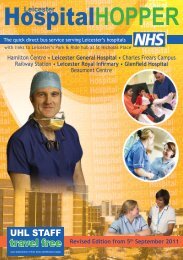Evaluation of the Crash Course March 2009 - De Montfort University
Evaluation of the Crash Course March 2009 - De Montfort University
Evaluation of the Crash Course March 2009 - De Montfort University
You also want an ePaper? Increase the reach of your titles
YUMPU automatically turns print PDFs into web optimized ePapers that Google loves.
frequently “scared about <strong>the</strong> driving” (p=0.006), from which an inference might be<br />
drawn that <strong>the</strong>y had become more sensitive to risk.<br />
The qualitative evidence from both adult stakeholders and young people provided<br />
anecdotal examples <strong>of</strong> changes in behaviour after <strong>the</strong> course that were sufficiently<br />
credible to provide some triangulation for <strong>the</strong> quantitative findings. These examples<br />
concerned not only <strong>the</strong> wearing <strong>of</strong> seatbelts but o<strong>the</strong>r changes such as persuading<br />
drivers to desist from mobile phone use or refusal to be a passenger with a driver<br />
who had been drinking. Some <strong>of</strong> <strong>the</strong> young people were clearly being a positive<br />
influence on <strong>the</strong>ir peers or <strong>the</strong>ir families.<br />
Are <strong>the</strong> content and delivery <strong>of</strong> <strong>the</strong> programme appropriate for <strong>the</strong> primary target age<br />
group?<br />
The researchers observed <strong>the</strong> course in action with young people on five occasions.<br />
The presentation held <strong>the</strong> attention <strong>of</strong> <strong>the</strong> vast majority <strong>of</strong> <strong>the</strong> young people for <strong>the</strong><br />
full two hours, which was not expected given <strong>the</strong> normal attention span for such<br />
groups.<br />
There were no technical problems in any <strong>of</strong> <strong>the</strong> presentations observed. The team<br />
handled <strong>the</strong> material and <strong>the</strong> different media competently and moved well from one<br />
item to ano<strong>the</strong>r. The presentation was widely described by stakeholders as “very<br />
pr<strong>of</strong>essional”. On a very few occasions it appeared that one or o<strong>the</strong>r speaker was<br />
losing <strong>the</strong> attention <strong>of</strong> some <strong>of</strong> <strong>the</strong> audience but since <strong>the</strong> presentation is so varied<br />
and moves from one topic or film item to ano<strong>the</strong>r, this was not a major concern.<br />
At <strong>the</strong> start <strong>of</strong> <strong>the</strong> observation visits, some members <strong>of</strong> <strong>the</strong> team feared that <strong>the</strong><br />
material would be overwhelming and too distressing for 15 or 16 year-olds.<br />
Considerable numbers from <strong>the</strong> school audiences did leave <strong>the</strong> room in tears though<br />
quite a number came back in later. In <strong>the</strong> light <strong>of</strong> <strong>the</strong> findings, this concern has<br />
however now dissipated. Only 34 <strong>of</strong> those completing <strong>the</strong>ir opinions after seeing <strong>the</strong><br />
presentation found it “too scary” and 76 felt it upset <strong>the</strong>m too much. Focus groups<br />
and teacher stakeholders confirmed that <strong>the</strong> force <strong>of</strong> <strong>the</strong> messages was perceived<br />
as legitimate, especially given that parents had given permission and any pupil could<br />
opt out. The fear-based messages need to be <strong>of</strong> sufficient strength to motivate a<br />
response and <strong>the</strong> researchers felt that approximately <strong>the</strong> right level was reached.<br />
<strong>De</strong>spite some suggestions in <strong>the</strong> young people’s responses for making <strong>the</strong> content<br />
even more fear-inducing, <strong>the</strong>re is no indication that this is necessary to produce<br />
impact and in <strong>the</strong> view <strong>of</strong> <strong>the</strong> research team it is undesirable and could lead <strong>the</strong><br />
presentation in <strong>the</strong> territory <strong>of</strong> gratuitously violent or distressing images.<br />
While many 15 or 16 year olds still have mercifully little life experience on loss,<br />
trauma, or bereavement to relate to <strong>the</strong> course content, <strong>the</strong>re was no evidence that<br />
any significant proportion were ‘shutting <strong>of</strong>f’ from <strong>the</strong> messages. The focus groups<br />
confirmed that most <strong>of</strong> those respondents felt <strong>the</strong> shocking nature <strong>of</strong> <strong>the</strong> course was<br />
necessary and that it did not cause shutting down <strong>of</strong> responses or particular<br />
resistance. The researchers would agree with <strong>the</strong> suggestion made in <strong>the</strong> focus<br />
groups that <strong>the</strong> course should not be presented to pupils any younger than Year 11.<br />
64





